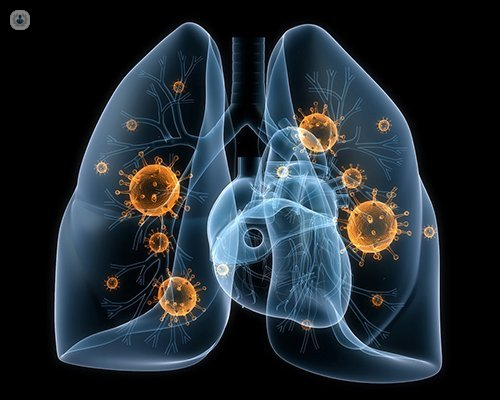What is bronchiectasis, and how is it managed?
Escrito por:In this article below, highly regarded consultant respiratory physician, Dr Tim Gatheral, tells us about some of the most effective ways one can effectively manage bronchiectasis.

What is bronchiectasis?
Bronchiectasis is a chronic lung condition characterised by the abnormal widening and inflammation of the bronchial tubes, resulting in a build-up of mucus and recurrent lung infections. While bronchiectasis is a lifelong condition with no cure, effective management strategies can help control symptoms, prevent complications, and improve quality of life for individuals living with the condition.
What are the best ways one can manage bronchiectasis?
One of the key aspects of managing bronchiectasis is airway clearance techniques. These techniques aim to help remove excess mucus from the lungs, reducing the risk of infections and improving lung function.
Common airway clearance techniques include chest physiotherapy, postural drainage, percussion, and vibration. These techniques can be performed independently or with the assistance of a respiratory therapist, and they are typically customised to meet the individual needs and preferences of each patient.
In addition to airway clearance techniques, staying hydrated is essential for individuals with bronchiectasis. Drinking plenty of fluids helps to thin mucus secretions, making them easier to clear from the airways.
It is also important to avoid environmental irritants and respiratory infections, as these can exacerbate symptoms and increase the risk of flare-ups. Quitting smoking and avoiding exposure to second-hand smoke are also crucial steps in managing bronchiectasis, as smoking can worsen lung function and increase the risk of respiratory infections.
Medications may also be prescribed to help manage symptoms and prevent complications in individuals with bronchiectasis. These may include bronchodilators to help open the airways, mucolytics to thin mucus secretions, antibiotics to treat bacterial infections, and corticosteroids to reduce inflammation in the airways. It is important for patients to take their medications as prescribed and to follow up regularly with their healthcare provider to monitor their condition and adjust treatment as needed.
Finally, pulmonary rehabilitation programmes can be beneficial for individuals with bronchiectasis, as they provide education, exercise training, and support to help improve lung function, increase exercise tolerance, and enhance overall quality of life. These programs typically involve a multidisciplinary team of healthcare professionals, including respiratory therapists, physiotherapists, and dietitians, who work together to address the diverse needs of patients with bronchiectasis.
To make an appointment with Dr Tim Gatheral, head on over to his Top Doctors profile today to do just that.


